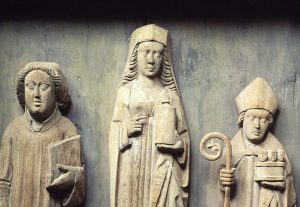A Short Reflection on Mapping Saints in 2021
2022-02-01
Sara Ellis-Nilsson, Linnaeus University
The following content was originally published as a thread on Twitter @MappingSaints (Jan. 18, 2022). It has been edited for clarity.
At the beginning of a new year, it’s once again time to reflect on the project and, this time, our work in 2021.
The database has continued to grow and develop, with a lot of data being added. The interface now features a short description of the project and the research resource which is still under construction. The input interface, Mapping Saints, can now be viewed online, here: saints.dh.gu.se
In 2021, we focused on data input, creating places on the Finnish map, refining our database model, and implementing IIIF.
This update thread from April 2021 highlights that from mid-March to mid-June, Steffen Hope joined us as a research assistant to assist with the transcription and input of those calendar fragments that have images in the Medieval Parchment Cover database (MPO) at the Swedish National Archives.
Our collaborative partner, the Center for Digital Humanities, University of Gothenburg, where our research engineer, Johan Åhlfeldt, is based, has been working hard to implement a IIIF-server so we can utilize this to retrieve and view images directly in our research resource, including letters in the SDHK (Medieval charters/Svenskt diplomatarium) database and fragments in MPO. Johan has also worked with testing the possible implementation of an xml-editor.
Throughout 2021, we were also active in presenting the project at conferences, such as at the (online) International Congress on Medieval Studies in May, in a session entitled ‘Saints Online’ together with other exciting mapping saints projects. In addition to co-writing an article about the spatial research data infrastructure of the project (forthcoming in 2022), we published an article in 2021 focusing on the project’s art historical aspects and the digitization work done in collaboration with our partners the Swedish National Heritage Board and the Swedish National Historical Museums. The article is available here: ojs.abo.fi/ojs/index.php/
We were joined by three student interns from the Department of History, Lund University, who input miracle stories. Our student research-assistant, Andreas Blixt, continued his work by inputting church bell and runic inscriptions, the latter including linking to relevant posts in the new database, ‘Runor‘.
Over the course of the autumn, we focused on questions of how we model time in the database, resulting in the implementation of a “function time-period” for our Cult Manifestations – enabling visualizations in both time and space.
From 2021-2023, our Wallenberg postdoc Sofia Lahti will be working with the Finnish art historical material. Speaking of Finland, starting in the spring 2022, we are also looking forward to finally beginning the delayed collaboration with our “sister” project, Lived Religion in Medieval Finland!
In addition to our Finnish collaborations and continued data input, our main goal in 2022 is to develop our future user interface. The first steps towards this goal will address appearance and functionality, as well as enabling visualizations and analyses.
Thanks to everyone who has helped us and shown an interest along the way! Keep yourselves posted on further developments via Twitter or here on our blog!


Recent Comments